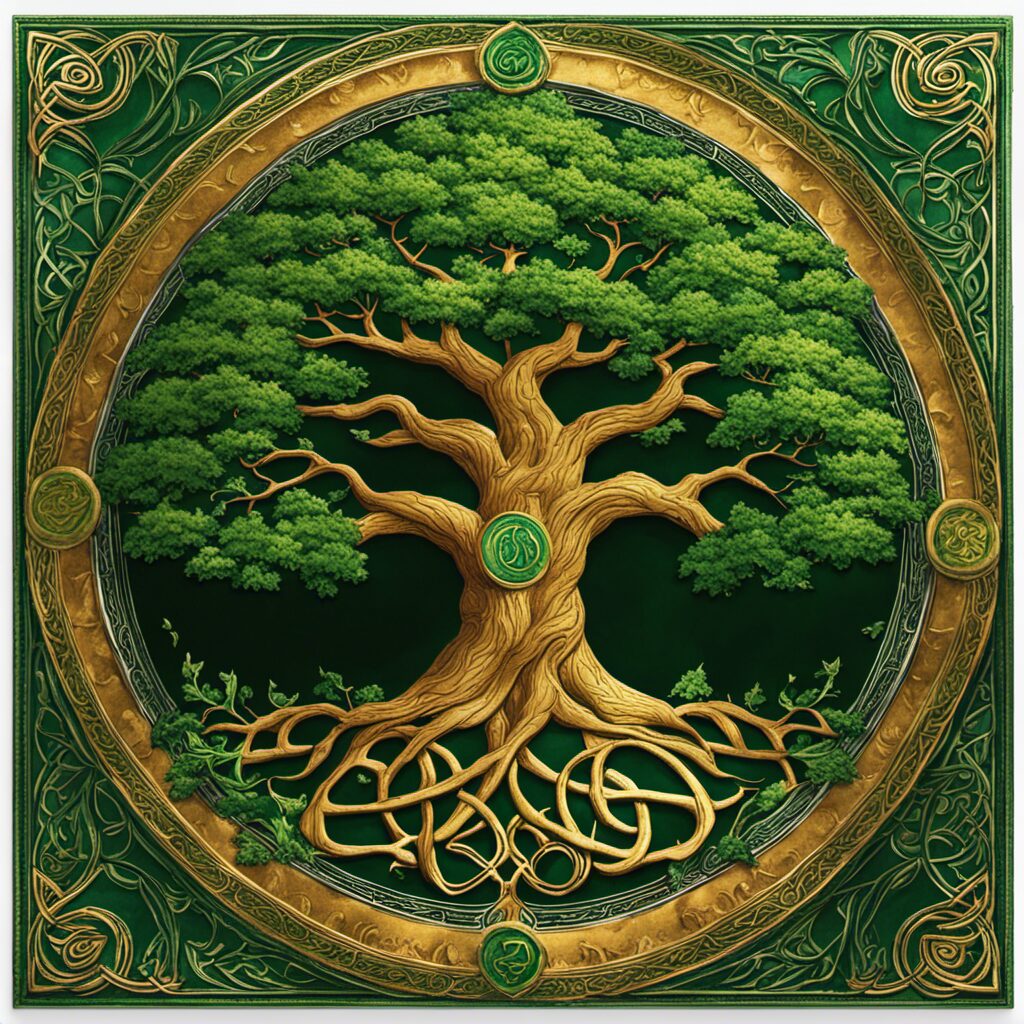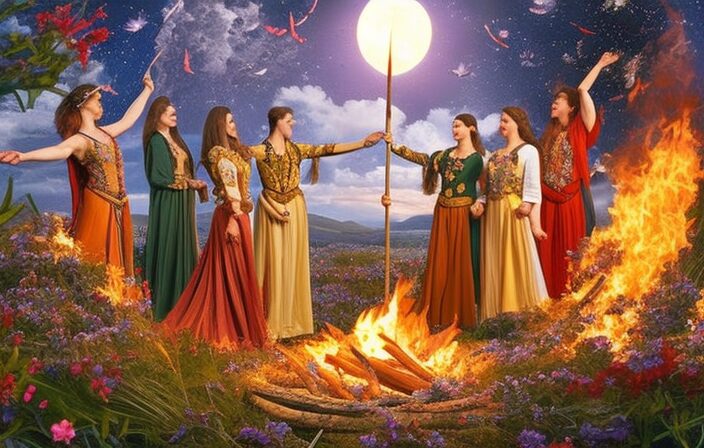The Celtic calendar is an ancient timekeeping system that organizes the passage of seasons into four distinct periods. This article explores the origins and significance of the Celtic calendar, focusing on its association with the four seasons: Samhain, Imbolc, Beltane, and Lughnasadh.
Drawing on comprehensive research and analysis, this study aims to provide a thorough understanding of how the Celtic people perceived and celebrated the changing cycles of nature. By delving into their cosmological beliefs and cultural practices, we can gain valuable insights into their connection with the natural world.
Key Takeaways
- The Celtic calendar is rooted in ancient Celtic cultures and is based on a lunar-solar system.
- It consists of two main divisions: the Coligny calendar and the Irish calendar, incorporating astronomical observations and religious beliefs.
- The calendar divides time into seasons based on agricultural cycles and is celebrated through seasonal rituals and gatherings.
- Each season holds symbolic meaning, representing rebirth and renewal in spring, abundance and vitality in summer, transition and reflection in autumn, and wisdom in winter.
Origins of the Celtic Calendar


The origins of the Celtic calendar can be traced back to ancient Celtic cultures and their observance of the natural cycles and seasons. The Celts were an Indo-European people who inhabited parts of Western Europe from around 1200 BCE to the Roman conquest in the first century CE. They had a deep connection with nature and believed that it played a crucial role in their lives.
The Celtic calendar was based on a lunar-solar system, combining both lunar phases and solar events such as solstices and equinoxes. It consisted of two main divisions: the Coligny calendar, used by the Gauls, and the Irish calendar, used by the Gaels. These calendars were complex systems that incorporated astronomical observations and religious beliefs.
Celtic traditions placed great importance on agricultural cycles, which influenced their division of time into different seasons. The four main festivals celebrated in accordance with these seasons were Imbolc (early February), Beltane (May 1), Lughnasadh (August 1), and Samhain (October 31). Each festival marked a significant turning point in nature’s rhythms, such as the beginning of spring or harvest season.
The Celtic Wheel of the Year


This discussion will focus on the seasonal celebrations and rituals, symbolism and significance, as well as modern interpretations and adaptations associated with the Celtic Wheel of the Year.
Seasonal celebrations and rituals were an integral part of ancient Celtic culture, marking important transitions in nature and human life. These celebrations often involved communal gatherings, feasting, storytelling, and various religious practices.
The symbolism and significance behind these rituals can be explored through the understanding of the natural elements, deities, and mythological narratives that shaped Celtic cosmology.
Additionally, this discussion will examine how modern interpretations and adaptations have evolved over time to accommodate changing cultural contexts while still honoring the rich traditions of the Celtic Wheel of the Year.
Seasonal Celebrations and Rituals
Seasonal celebrations and rituals associated with the Celtic calendar are an integral part of their cultural practices. These traditions have been passed down through generations and reflect the deep connection that the Celts have with nature and the changing seasons. Ancient rituals were performed to honor and acknowledge the cycles of life, death, and rebirth.
The four major seasonal festivals celebrated by the Celts were Imbolc, Beltane, Lughnasadh, and Samhain. Imbolc marked the beginning of spring and was a time for purification rituals. Beltane celebrated fertility and abundance in early summer. Lughnasadh honored the harvest season, while Samhain commemorated the end of summer and ushered in winter.
These celebrations involved various customs such as bonfires, feasting, dancing, divination, and offerings to gods or spirits. Today, many people continue to observe these ancient traditions as a way to connect with their Celtic heritage and celebrate nature’s rhythms.
Symbolism and Significance
Symbolism and significance are inherent in the rituals and celebrations of the Celtic calendar, reflecting a deep understanding and reverence for the natural world. The Celtic people had a profound connection with nature, which is exemplified in their calendar and its associated festivities.
Each season holds its own symbolic meaning within this ancient tradition. Spring represents rebirth, renewal, and growth, symbolized by the blooming flowers and budding trees.
Summer embodies abundance and vitality, with feasts and gatherings to celebrate the bountiful harvests.
Autumn signifies transition and reflection as nature prepares for winter’s arrival, symbolizing wisdom gained through experience.
Winter represents introspection, darkness, and the cycle of life as it retreats into hibernation before emerging once again in spring.
These symbols hold cultural significance for the Celts, connecting them to their land, traditions, ancestors, and cycles of life itself.
Modern Interpretations and Adaptations
One way to understand the cultural significance and timeless relevance of the Celtic calendar is through examining modern interpretations and adaptations.
In contemporary society, the Celtic calendar has been embraced by various individuals and groups who seek to connect with their Celtic heritage or simply appreciate its mystical symbolism.
Modern interpretations of the Celtic calendar often involve incorporating its themes into artwork, jewelry, clothing, and home decor. Additionally, there are numerous books, websites, and social media platforms dedicated to explaining the intricacies of the calendar and providing guidance on how to incorporate its principles into daily life.
Cultural adaptations of the Celtic calendar can also be observed in festivals and events that celebrate its traditions, such as Beltane fire ceremonies or Samhain rituals.
Overall, these modern interpretations and adaptations serve to keep the rich cultural heritage of the Celtic calendar alive in contemporary times.
Samhain: The Celtic New Year


Samhain, the Celtic New Year, marks the end of the harvest season and serves as a time to honor ancestors and connect with the spirit world. This ancient festival was celebrated by the Celts and is still observed by modern-day practitioners of Celtic traditions. Samhain, which means ‘summer’s end’ in Gaelic, is traditionally held on October 31st and November 1st. During this time, it was believed that the veil between the physical world and the Otherworld was at its thinnest, allowing spirits to freely roam among the living.
The rituals associated with Samhain were deeply rooted in Celtic traditions. Bonfires were lit to ward off evil spirits and provide warmth during the approaching winter months. People would also leave offerings of food and drink for their departed loved ones, believing that they could communicate with them during this liminal period.
In addition to honoring ancestors, Samhain was seen as a time for divination and prophecy. Ancient rituals such as apple bobbing or throwing nuts into a bonfire were performed to gain insight into future events or determine one’s fate.
Today, many people continue to celebrate Samhain as a spiritual holiday. It has become intertwined with Halloween in some cultures but retains its significance within Celtic communities. The enduring nature of these ancient rituals highlights their importance in maintaining cultural identity and connecting with ancestral heritage.
Imbolc: The Coming of Spring


Imbolc, another significant festival in the Celtic tradition, marks the arrival of spring and is observed as a time of purification and new beginnings. This festival is celebrated on February 1st or 2nd and is associated with the goddess Brigid.
Imbolc holds great symbolism and customs that reflect its connection to the changing seasons and the renewal of life. Some key elements of this festival include:
-
Lighting fires: Imbolc signifies the end of winter darkness and the return of light. Lighting fires symbolizes purification, protection, and warmth.
-
Candle making: Candles are crafted during this time to represent light emerging from darkness. These candles hold symbolic importance in homes and sacred spaces.
-
Spring cleaning: Imbolc is a time for cleansing both physically and spiritually. It involves thorough cleaning of homes to remove any stagnant energies from winter.
-
Making traditional foods: Traditional recipes associated with Imbolc include dishes made from dairy products such as butter or cheese, which symbolize fertility.
Imbolc serves as a reminder that nature’s cycles continue even in harsh winters, bringing hope for new beginnings. The customs practiced during this festival reinforce these themes by purifying spaces, illuminating darkness, and embracing seasonal transitions through food preparation.
Beltane: The Celebration of Life


Beltane, a significant festival in the Celtic tradition, is celebrated as a joyous occasion that honors life and fertility. This ancient celebration takes place on May 1st and marks the beginning of summer in the Celtic calendar. Beltane, also known as May Day, has its roots in ancient agrarian practices and is closely associated with celebrating fertility and abundance.
During Beltane, rituals and ceremonies are performed to promote growth and ensure a bountiful harvest. The focus of these rituals is typically on fire, which symbolizes purification and transformation. Bonfires are lit to bring blessings upon the land, livestock, and people participating in the festivities.
The celebration of Beltane involves various customs that have been passed down through generations. These include dancing around the maypole, a phallic symbol representing fertility; adorning homes with flowers; gathering herbs for medicinal purposes; and engaging in courtship rituals. These traditions underscore the importance of community cohesion and emphasize the interconnectedness between humans and nature.
Beltane’s significance lies not only in its commemoration of fertility but also in its role as an important marker of seasonal change within the Celtic calendar. It serves as a reminder of our connection to nature’s cycles while honoring age-old traditions that continue to inspire communities today.
Lughnasadh: The Harvest Festival


Lughnasadh, a traditional festival celebrated in various cultures, commemorates the harvest season and emphasizes the importance of agricultural abundance. This ancient celebration is deeply rooted in the history of agriculture and serves as a reminder of the vital role that farming played in sustaining communities throughout history. Lughnasadh is still observed today by many people who wish to pay homage to their ancestors’ hard work and express gratitude for the bountiful harvest.
To better understand Lughnasadh and its significance, it is important to consider some key elements associated with this festival:
-
Feast: Lughnasadh is typically marked by a grand feast where families and communities gather to share food. This feast symbolizes abundance and prosperity resulting from successful harvests.
-
Games: Traditional athletic competitions are often held during Lughnasadh festivities. These games were not only a form of entertainment but also served as a way to showcase physical prowess and strength, qualities highly valued in ancient agricultural societies.
-
Rituals: Ceremonies dedicated to deities associated with agriculture, such as Lugh or Demeter, are performed during Lughnasadh. These rituals seek divine blessings for future crops and ensure continued fertility of the land.
-
Crafts: The creation of handicrafts using harvested materials is another integral part of Lughnasadh. These crafts not only demonstrate creativity but also represent skills passed down through generations, reflecting the intergenerational knowledge transfer inherent in ancient agricultural practices.
Overall, Lughnasadh stands as a testament to humanity’s enduring connection with nature and our dependence on agricultural abundance for survival. Through celebrating this festival, we honor our ancestors’ laborious efforts while recognizing the significance of sustainable farming practices in ensuring future prosperity.
Conclusion
In conclusion, the Celtic calendar is a fascinating ancient system that divided the year into four distinct seasons. It originated from the agricultural practices and beliefs of the Celtic people. The Celtic Wheel of the Year symbolizes the cyclical nature of life and celebrates important festivals such as Samhain, Imbolc, Beltane, and Lughnasadh. These festivals mark significant moments in the agricultural calendar and serve as celebrations of life, death, rebirth, and harvest. The rich cultural heritage preserved in the Celtic calendar continues to captivate scholars and enthusiasts alike with its profound symbolism and enduring relevance. Its influence can still be felt today in modern Pagan traditions around the world.
Overall, this ancient calendar system offers a unique perspective on timekeeping that goes beyond mere measurements of days and months. It highlights the interconnectedness between humans, nature, and cosmic forces. Such a holistic approach to time not only aids in understanding past cultures but also encourages us to appreciate our own place within the natural world. The Celtic calendar’s enduring legacy reminds us of our deep-rooted connection to nature’s rhythms throughout history—an invaluable reminder of our shared human experience.
In conclusion, exploring the intricacies of ancient calendars like the Celtic one allows us to uncover layers upon layers of knowledge about civilizations long gone—one might even say it is like peeling back centuries-old layers of an archaeological treasure trove!




